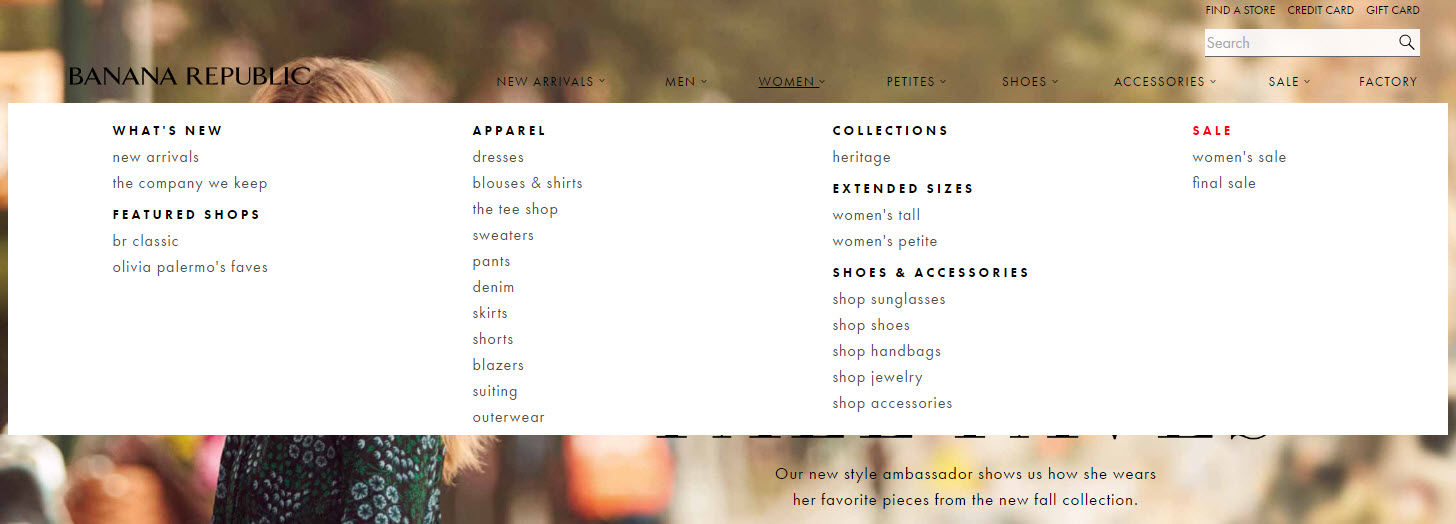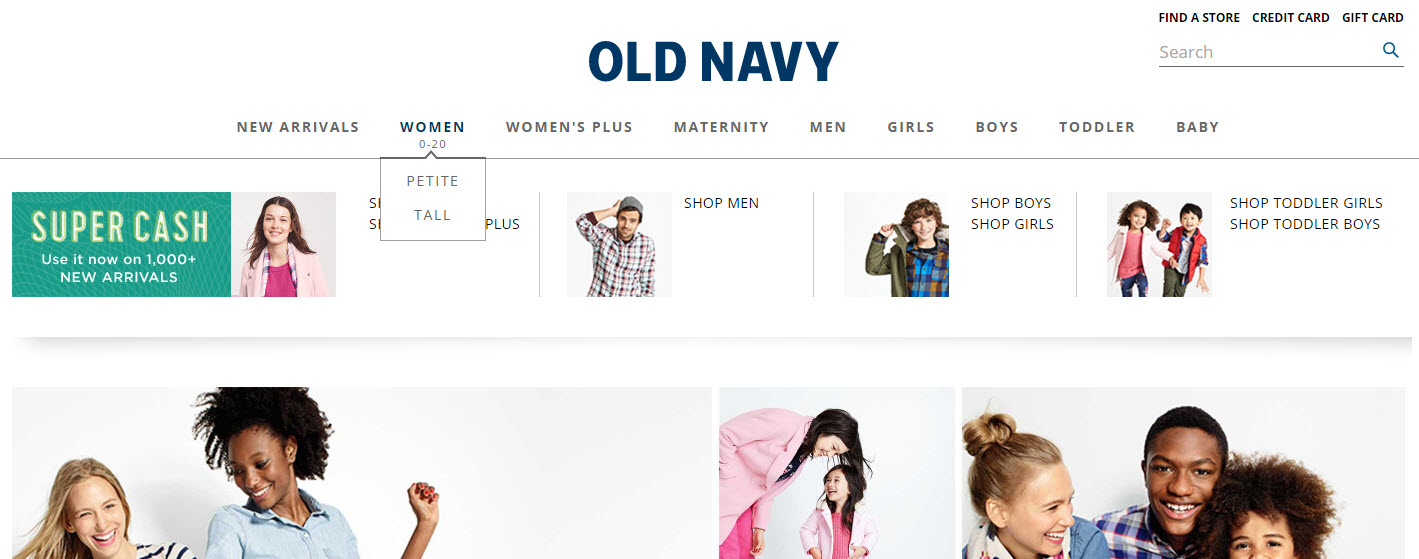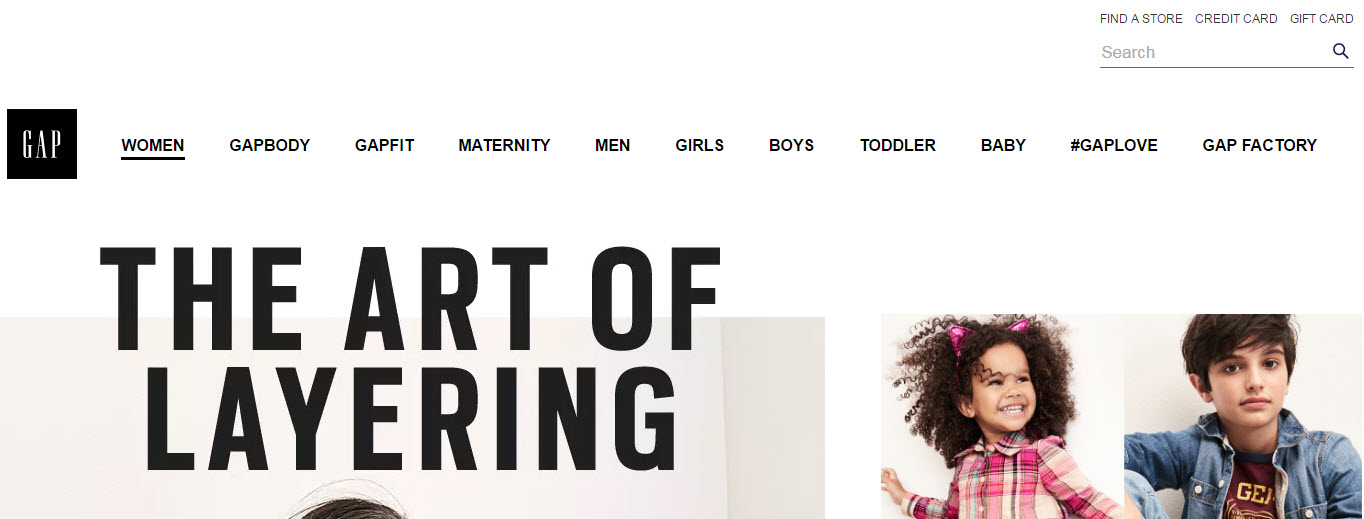The trend toward simplicity in web design is affecting navigation. The impact on search engine optimization of navigation changes can be staggering. Navigation isn’t just a way for shoppers to navigate. It’s critical to natural search performance.
Complex navigational forms like mega-navigation — a navigational header that scrolls down when rolled over, spanning the full page and taking up inches of valuable screen space — have become so prevalent that some sites are starting to rebound the other direction toward simplification.
Mega-navigation is very beneficial to SEO, but its also considered potentially tiring or confusing to shoppers who have to wade through it to locate the type of products they want to purchase. In addition, the visual weight of the navigation’s design can detract from the brand image and messaging that the site is designed to communicate.
For example, the navigational design on three of the sites that Gap Inc. owns — Gap, Banana Republic, and Old Navy — reflect steps in this trend away from mega-navigation. Banana Republic, below, still uses the mega-navigation concept with links down to the third level of the site. The first level is the home page. The second level comprises the main categories like “Men” and “Women.” The third level contains “Dresses,” “Pants” and the like.

Banana Republic’s mega-navigation offers deep links into the site.
Old Navy previously featured a similar mega-navigation style. But it simplified, to offer only links into size types from the header, as shown below. In this way, Old Navy has removed navigational links from all but the second-level “Men” and “Women” categories, with a couple of third-level size links included in those categories that offer multiple size types like “Petite” and “Tall.”

Old Navy’s header navigation links solely to categories and a handful of size types.
Gap has removed rollover-based navigational links entirely, and links only to the main categories in level two, like “Men” and “Women.” In the image below, the only change that happens when a shopper mouses over a link in the header is that the category title is underlined to indicate where the shopper would be clicking.

Gap has removed mega-navigation entirely.
In extreme cases, sites move away from complex navigation to an internal, search-based model where shoppers rely on internal search and its filters to find the products they want to purchase. Header navigation links in those instances would be more like an optional and secondary road to travel. More typically, sites remove some or all of their third- or fourth-level navigational links to increase the visibility of the higher-level options.
Unfortunately, all of this affects search engine optimization. The move to expanded navigation benefitted SEO by adding more links into the site-wide navigation that could pass authority deeper into the site and extend indexation. Conversely, the move away from more complex navigational models will detract from natural search performance.
Authority and Relevance
Navigational links are not just for customers — they’re conductors of authority and relevance signals for search engines. When one page links to another, it’s a vote of confidence that that page being linked to is important. The link typically contains anchor text as well – the words you click to get to the next page – which conveys a vote of relevance to help search engines understand what that page is about. Without those links, authority and relevance signals are not passed deeper into the site to help more pages on the site rank more strongly and drive additional shoppers to the site.
Links also act as pathways for discovering content. If a page isn’t linked to in some fashion it’s considered orphaned. An orphaned page has no signals of authority from its own site and thus has very little chance to rank unless, for some reason, other sites know it’s there and link to it heavily. Aside from authority, though, search engines have no clear way to discover orphaned pages to index them, and indexation is the first step toward ranking. Yes, HTML sitemaps and XML sitemaps can technically offer a method to get a page indexed. But without presence in some form of standard navigation from somewhere on the site, those pages won’t have the authority to rank.
Removing one link from navigation can cause SEO professionals to run for their analytics to analyze the potential impact and offer alternate solutions. Removing whole levels of site access when simplifying a mega-navigational structure impacts the ability to pass authority deeper into the site on a whole different scale.
Other Options?
When asked about removing items from the mega-navigation or other navigational structures, I always first ask “Why?” and, secondly, “Do you absolutely have to; what are the other options?” In some cases, the navigation is a sprawling, giant mess — there’s little doubt that it should be cleaned up. But even then, before deciding to remove items from the navigation, do a worst-case scenario analysis.
In your web analytics, go to the natural search entry pages report. This report should be your go-to for SEO performance, anyway. If it’s not, read my reasoning at “SEO: Measuring Key Performance Indicators.” If you don’t have access to your site’s web analytics, view the top pages report in Google Web Console for similar data.
In the entry pages report for natural search, look for the pages or URLs that would be removed. The visits and sales for those pages are based upon their inclusion in navigational structures today. Removing them from the navigation, pushing them down a level in the navigation, nesting them under another level in the navigation: All of those things will undoubtedly impact their ability to drive traffic and sales via natural search.
What happens, in the worst-case scenario, if the traffic and sales for those pages disappear overnight? In some cases, performance today is very low and therefore the decision is easy to make.
But for those pages that drive meaningful natural search traffic and sales, the decision should be considered at length. Look for other options. Weigh the costs and the benefits against the other needs being considered. SEO can’t be the only consideration. But make sure that your business has the data to understand the SEO impact of every navigational change.





